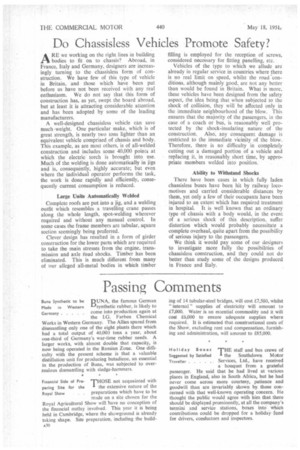Do Chassisless Vehicles Promote Safety?
Page 32

If you've noticed an error in this article please click here to report it so we can fix it.
ARE we working on the right lines in building bodies to fit on to chassis? Abroad, in France, Italy and Germany, designers are increasingly turning to the chassisless form of construction. We have few of this type of vehicle in Britain, and those which have been put before us have not been received with any real enthusiasm. We do not say that this form of construction has, as yet, swept the board abroad, but at least it is attracting considerable attention and has been adopted by some of the leading manufacturers.
A well-designed chassisless vehicle can save much .weight. One particular make, which is of great strength, is nearly two tons lighter than an equivalent vehicle comprised of chassis and body. This example, as are most others, is of all-welded construction and includes some 40,000 points at which the electric torch is brought into use Much of the welding is done automatically in jigs and is, consequently, highly accurate; but even where the individual operator performs the task, the work is done rapidly and efficiently, consequently current consumption is reduced.
Large Units Automatically Welded Complete roofs are put into a jig, and a welding outfit which resembles a travelling crane passes along the whole length, spot-welding wherever required and without any manual control. In some cases the frame members are tubular, square section seemingly being preferred.
Clever design has resulted in a form of girder construction for the lower parts which are required to take the main stresses from the engine, transmission and axle foad shocks. Timber has been eliminated. This is much different from many of our alleged all-metal bodies in which timber filling is employed for the reception of screws, considered necessary for fitting panelling, etc.
Vehicles of the type to which we allude are already in regular service in countries where there is no real limit on speed, whilst the road conditions, although mainly good, are hot any better than would be found in Britain. What is more, these vehicles have been designed from the safety aspect, the idea being that when subjected to the shock of collision, they will be affected only in the immediate neighbourhood of the blow. This ensures that the majority of the passengers, in the case of a coach or bus, is reasonably well protected by the shock-insulating nature of the construction. Also, any consequent damage is restricted to the immediate vicinity of the blow. Therefore, there is no difficulty in completely cutting out a damaged portion of a vehicle and replacing it, in reasonably short time, by appropriate members welded into position.
Ability to Withstand Shocks There have been cases in which fully laden chassisless buses have been hit by railway locomotives and carried considerable distances by them, yet only a few of their occupants have been injured to an extent which has required treatment in hospitaL It is well known that an ordinary type of chassis with a body would, in the event of a serious shock of this description, suffer distortion which would probably necessitate a complete overhaul, quite apart from the possibility of serious injury to the passengers.
We think it would pay some of our designers to investigate more fully the possibilities of chassisless construction, and they could not do better than study some of the designs produced in France and Italy.




























































































